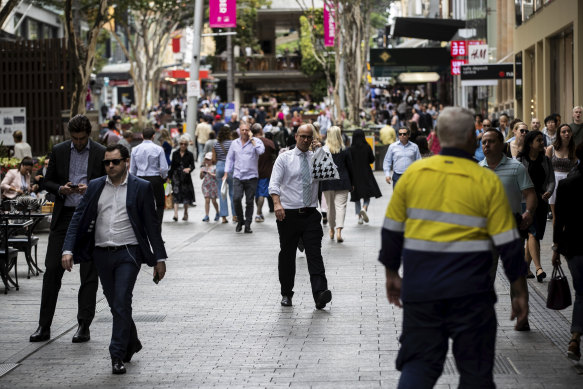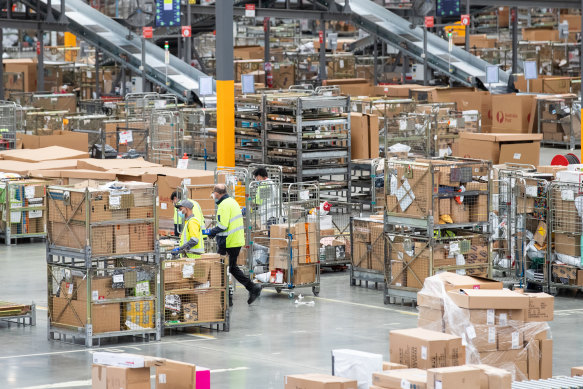Six things company profits reveal about our spending
Corporate report cards are in, and one narrative is becoming increasingly clear: the party is over. People are spending less, cooking at home more, and counting their pennies.
But the spending slowdown is happening gradually after a years-long national shopping spree, and consumers are still willing to fork out for expensive plane tickets and travel experiences.
While official economic data from the Australian Bureau of Statistics is widely used as a measure of consumer sentiment, the profit and loss statements from Australia’s biggest companies paint a colourful picture of what people are doing with their budgets.

We’ve crunched the numbers of financial reports released over the past month by some of Australia’s biggest companies, including Woolworths, Coles, Super Retail Group, Harvey Norman, CBA and Qantas, to uncover what the numbers say about how households are responding to pressures around the cost of living.
Supermarkets, discount players are making big bucks
Profits jumped at supermarket giants Coles and Woolies as their bosses highlighted shoppers are moving their spending away from more specialist retailers to budget-friendly grocery and homewares options.
Woolworths boss Brad Banducci called this trend “trading in”, noting that Australian households also been curbing their weekly takeaway habits in favour of making meals together at home.
Discount department store darling Kmart staged a post-pandemic rebound, with sales across all categories surging as shoppers hunted for value. “We’re not just the domain of people on lower incomes,” boss Ian Bailey said.
And numbers from Supercheap Auto and Rebel owner Super Retail Group also added to the evidence that consumers are happy to make smaller-scale purchases and buy the essentials, whether it’s kids sports shoes or auto essentials. Profits climbed by 38 per cent for the six months to December. Super Retail boss Anthony Heraghty highlighted that many of its products were essential.
“If my light bulb is broken on the brake light, I’ll get a new brake light,” he said.
Watch the banks: The tide is turning
If sentiments about the big banks are anything to go by, 2023 has heralded a very different economic and spending environment: Australians are watching their wallets, which have been squeezed by higher and higher mortgage bills (the ACCC has noticed savings rates are not climbing at the same rate).
Commonwealth Bank and NAB’s cash earnings lifted 9 per cent and 19 per cent respectively, fattened by rising interest rates. But further rate rises are starting to work against the banks. With CBA’s margins peaking in October, analysts suspect that this is as good as it gets before bad debts begin to rise, sparking a train of earnings downgrades.
“This is a game changer for its earnings trajectory, with each additional rate rise now an incremental headwind,” said Barrenjoey analyst Jonathan Mott.
The Reserve Bank is meeting again on Tuesday and is predicted to lift interest rates for the 10th time in a row. Households will again have to funnel more of their paycheck towards servicing mortgages and paying energy bills, with even less available for discretionary spending.
Inflation is sticking around
It’s expected that inflation will stabilise this year and the food price rises of 2022 are unlikely to be repeated (9.2 per cent).
Flight prices should come down … theoretically
Despite high fuel prices, one thing airline chiefs are promising is lower airfares. Travel-starved passengers returned to the skies with a vengeance after borders reopened, albeit with a bit of turbulence, which led Qantas, Rex and Virgin to return to profitability in 2022.
Qantas boss Alan Joyce has said that airfares should be trending down as airlines add more capacity – Regional Express has secured two more Boeing 737-800s towards this end – meaning more seats, more competition, and lower prices.
Consumers will have to wait and see whether this does drive down fares after the chief executive defended the carrier’s pricing as it revealed $1 billion in half-year profits and a tripling of revenue to $9.9 billion.
“I will say Qantas does charge more than other airlines … because you get more value with Qantas in other areas, and it’s all about value. And a lot of customers will pay that extra,” he said last month.
Say goodbye to the online sales rush
While travel will be on the cards for a while yet, numbers from electronics and home goods seller Harvey Norman released last week provided evidence that consumers are slowing their spending of big-ticket items. The company revealed sales in January were 10 per cent weaker than the same time last year, blaming a cool summer on sluggish sales of air-conditioners and outdoor settings.

Throughout earnings season, investors punished online-only retailers hard when they also revealed that the COVID-19 sugar rush was over: Temple & Webster’s stock plummeted more than 25 per cent in a day after the company revealed a profit drop.
Online marketplaces Catch and Kogan also posted losses for the half, while beauty operator Adore Beauty told investors it was facing tough consumer spending conditions.
The online spending slowdown also extended to food, with pizza giant Domino’s saying it got the balance wrong when it increased food charges to cover inflation, which led to softer delivery sales.
Local players look beyond Australia
Another trend worth keeping an eye on is how businesses are turning back to the Chinese market now that borders have reopened, Canberra and Beijing are getting reacquainted, and trading conditions improve, with Costa Group and Milklab maker Noumi among two companies hoping to chase growth through export markets.
Treasury Wine posted a 72 per cent lift in profits as consumers kept reaching for luxury and premium wines over the festive season and it passed on price increases. Since China implemented its tariffs, it has been expanding its presence in the US and other Asian markets – but it’s kept a close handle on servicing the Chinese market, launching One by Penfolds, while chief executive Tim Ford prepares to visit China this month.
Most Viewed in Business
Source: Thanks smh.com